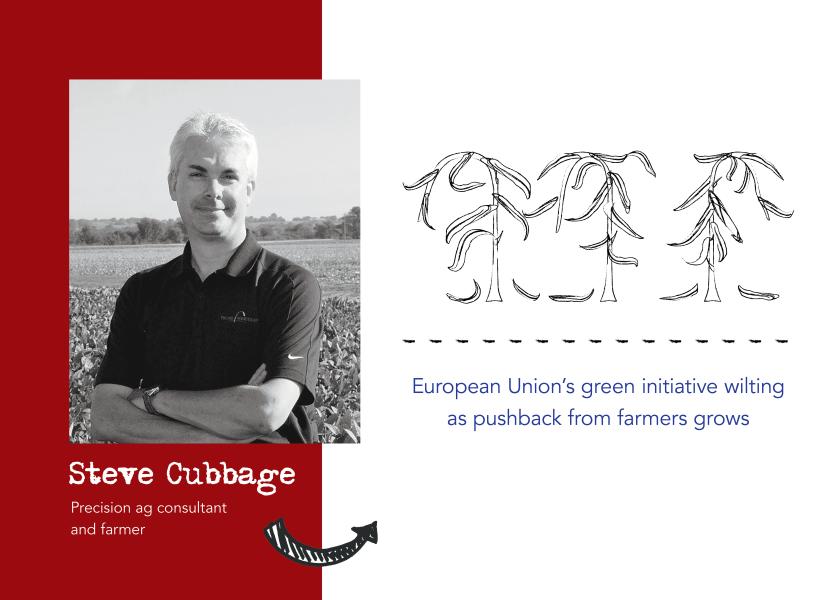Will Europe's Farmer Protests Make Their Way To The U.S.?

In case you haven’t heard, farmers across Europe are fed up with their politicians and bureaucrats telling them how to farm. Such sentiment is nothing new. What is new is that the level of frustration has grown to the point where thousands of farmers are taking to the streets with their 15-ton tractors and marching to the capitals and major cities of European countries to give government officials a message: enough already.
For those of us old enough to remember, this moment has a bit of historical déjà vu to it. Flash back to the late 1970s when on this side of the pond, Washington, D.C. was stormed by thousands of farmers driving their tractors to protest critically low commodities prices, higher input costs, falling land values and rising interest rates. This was the warning shot signaling even more dire times to come as the farm crisis of the 1980s followed.
Now, nearly 45 years later, the flame still burns. But this time the fire is taking off in Europe. The ingredients for the discontent are much the same—low prices, costly inputs, high interest rates and so forth. However, the recipe has added an ingredient that has quickly become the biggest fly in the soup as far as European farmers are concerned.
Policy Pushback
The European Green Deal, approved in 2020, is a set of policy initiatives established by the European Commission. Its overarching aim is to make the European Union (EU) climate-neutral by 2050. For European farmers, one of the most controversial components of the deal was the goal to reduce chemical fertilizer and pesticide use by 50% by 2030. That, combined with plans to idle more farmland to increase land biodiversity and forests, along with very little funding directed to farmers to facilitate and harbor such a transition, set the stage for a revolt.
From Berlin and Paris to Brussels and Bucharest, European farmers have driven their tractors to the streets in protest in recent weeks. In Germany, an estimated 30,000 protestors and thousands of tractors brought Berlin’s city centre “to a standstill” in mid-January due to dissatisfaction with the government over the cutting of agricultural fuel subsidies. The protests in France erupted over plans to reduce agricultural fuel subsidies and the government’s push to halve pesticide use by the end of this decade.
The situation escalated to a point where farmers sprayed manure on a local government building in the city of Dijon. In Paris, hundreds of tractors blocked off major roads into the country’s capital in what was called the “siege of Paris” by many media outlets—one of which being BBC News.
By mid-February, protests had spread to other European countries including Italy, Greece, Belgium, Poland, Spain and even Romania and Lithuania. There seems to be no sign of this fire going out any time soon. All the politicians can hope for is that springtime and Mother Nature will draw the farmers and their tractors back to their fields to sow their spring crops and allow the political firestorm to cool off.
But hope is not a strategy, and European farmers know it. Now the question may be how much of the “green gains” are EU’s leaders willing to concede in order to save their political hide. The European Commission, the executive arm of the EU, now intends to scrap the plan to halve pesticide use. It also decided to exclude the agricultural sector from the strict timeline for cutting greenhouse gas emissions by 90% before 2040. In Germany, farmers gained some concessions from the government on the issue of fuel subsidies but continue their demand for full reinstatement. On Feb. 1 in France, the main farmer unions called for an end to the protests after “securing promises of governmental assistance” on finance and regulatory issues. And in the EU’s home base, farmers “won their first concession from Brussels” after the commission proposed to delay rules for setting aside land for biodiversity.
Whether it is luck, strategy or irony on the part of the farmers, Europe’s reassessment of its climate policies comes as the bloc approaches EU parliamentary elections in June. The elections are expected to bring more far-right and fringe lawmakers into Parliament. Already, the continent’s political pundits are saying the next political cycle (2024-29) “will undoubtedly be less green to the point of putting into question the implementation of the green new deal.” Plus, the recent protests “are just a prelude of the further clashes to come.”
Too Many Sticks, Too Few Carrots
Will this fire jump the pond, and could we once again see tractors showing up on the National Mall in Washington, D.C.? Need I remind you, it is an election year here, too.
It is unfair and unwise to think farmers—no matter the continent where they live—are going to carry the costs of going green on their backs alone. At some point, all this needs to stop being an academic exercise and become an economic one. Start paying more to the farmer for carbon credits. Provide the tax incentives to finance the transition to “greener” farms. And stop with the rhetoric that burping cows are going to cause the next apocalypse.
Down on the farm in the U.S., the green agenda is at a crossroads. The question will be whether we will make the same mistakes Europe did and try to drive a green agenda too fast with a stick-heavy approach. The first litmus test may come sooner rather than later as Congress still has a new farm bill to pass. It is expected to be the “greenest” farm bill on record. This election year, given what’s happening in Europe, will our politicians pile on the carrots instead of giving us more sticks? Come November election time, we will see which road we are headed down.







